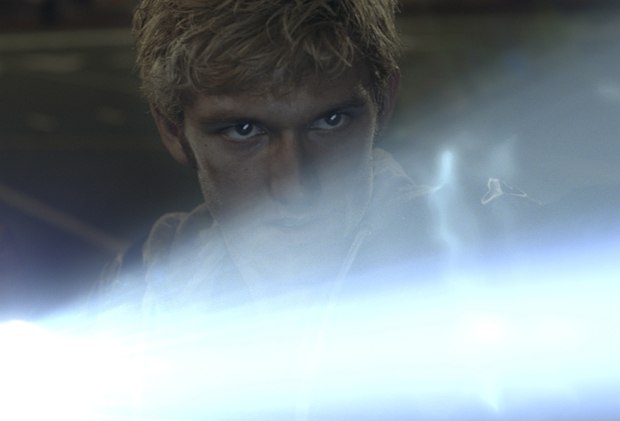Find out how they created the otherworldly mayhem in the latest sci-fi actioner produced by Michael Bay.
In I Am Number Four, directed by D. J. Caruso (Disturbia) and produced by Michael Bay (Transformers), nine alien toddlers are sent to earth to escape an invading race bent on destroying their planet. The Mogs track the Loriens on earth but can only kill them in sequence. The focus is on Number Four (Alex Pettyfer), who lives as a teenager in Ohio. Like Superman, he's developed superhuman powers, including enhanced strength, speed, agility and telekinesis.
With nearly 800 vfx shots under the overall supervision of Greg McMurry (G.I. Joe: The Rise of Cobra), the work was divided between ILM, Entity FX, Hammerhead, Shade and Dive, among others.
"The vfx included demonstrating these powers as well as the large reptilian-type hunting dogs, the Pikens, which belong to the Mogs, and are used to chase down the kids," explains McMurry.
ILM (under the supervision of Bill George) did the creature work, which comprised around 65 shots. There are two species of Piken: the baddies, which McMurry describes as a cross between a giant reptile and a flying squirrel, which are about 8-feet tall, can jump large distances and have webbed wing structures between their arms and legs; and the good-guy Bernie monster, which morphs from a gecko into a beagle before transforming into the canine beast that holds its own against the Piken in saving the alien kids.
"The shooting of plates to put these in a realistic environment was quite a challenge," McMurry relates. "We set out wanting to make sure everything was photographed as naturally as possible; we didn't want all the breakage to be some post-production CG event. So with the help of Peter Chesney, the overall special effects supervisor, we crashed these [heavy objects] called 'bucks' through an actual block wall. And then ILM went in and animated the creature in place of the buck. So it was our goal to have that very gritty, interactive, real stuff. Every scene was staged and shot as if the CG creatures were actually there. We used a lot of motion control for those purposes, to do interactive breakage, when a creature would come across a room and knock something over We wanted ILM to use the least amount of computer-generated interactive elements as possible."
The telekinetic powers were done by Hammerhead, which "designed a special slant of people lifting things and moving things." There is also Number Four's special power of Lumen, the ability to generate light out of his hands and arms, and Hammerhead "did these large, powerful light beams that could do anything from just light up his way at night to burn something like a powerful laser. We tried to maintain an organic and natural aspect to it and not look like something mechanical."
Another effect occurs when the Mogs get killed: they turn to a crusty substance and evaporate called "ashing." Entity FX, under the supervision of Mat Beck, did this effect along with the teleport speed effect for Number Six (Teresa Palmer).
The ashing effect uses 3D characters together with both particle and fluid simulations. Entity FX developed the look and, using the company's in-house software, customized sequences, such as having allies dematerialize more slowly and lyrically for individual shots. Entity FX also provided CG-animated bodies and body parts, energy effects, digital blood, glowing swords, exploding crystals, windshields, face replacements, split screens, greenscreen compositing, rig removal, set cleanup, makeup enhancements and a symbolic night sky.
Lumen is also transferred to other tools and Dive (under the supervision of Ed Mendez) contributed to the effect of the blue glow by combining an enhanced and lengthened motion blur with the original gleam from an LED crystal embedded in a sword. The team then manually tracked both the tip and bottom of this crystal in each shot due to the speed of the blades and the lighting in the shots.
Dive also used Paint when doing camera projections to aid the larger plate restoration areas; some trickier techniques were used when Number Four dives from a cliff over a waterfall. In this scene, the actor's wires were both behind thin strands of hair and in front of a pool of rippling water making for a tricky paint fix.
In terms of working with director Caruso, he "had very clear ideas of how he wanted the crews and actors to experience the effects sequences, which really assisted us in how we put them together. He wasn't one of these 'let's do it post' guys: he really wanted the actors to play out these sequences, and it gave us the leadership to understand how the practical side of the photography was going to drive our effects sequences.
"The final battle is a very physical one and we worked many nights in a high school football field where this takes place. And that whole scene ends up with an out of this world explosion that was a result of an alien weapon. Of course, here we are at this beautiful high school in Pennsylvania with a brand new football field. And we had to do blow up everything but we couldn't touch anything. We had to use every visual effect and special effect technique available without damaging the football field. We had to do it in pieces and so we shot lots of elements and the spectacular ending in a virtual environment, which ILM also helped with."
As for Bay, he participated heavily in the ultimate modeling and skin textures, and, from McMurry's perspective, "helped us understand what makes animated creatures exciting and answer the needs of the script."
Bill Desowitz is senior editor of AWN & VFXWorld.










